Research Highlights
Multiomic analysis of papillary thyroid cancers
In a recent study from our lab, we discovered in a patient with papillary thyroid carcinoma (PTC) a novel rearrangement leading to a BAIAP2L1-BRAF fusion, and whose transforming ability we have demonstrated. Furthermore, our integrative multiomics analysis of a cohort of PTC patients has uncovered additional druggable candidates, which seem to be more common targets, since the observed deregulation is independent of the underlying oncogenic mutation. Our multiomics analysis demonstrates how new targets can be identified, which in turn might have the potential to advance the field of precision medicine.
The study is published in Molecular Cancer
The study is published in Molecular Cancer
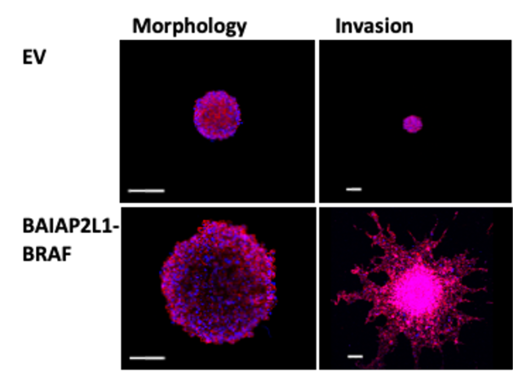
ARAF suppresses ERBB3 expression and metastasis in a subset of lung cancers
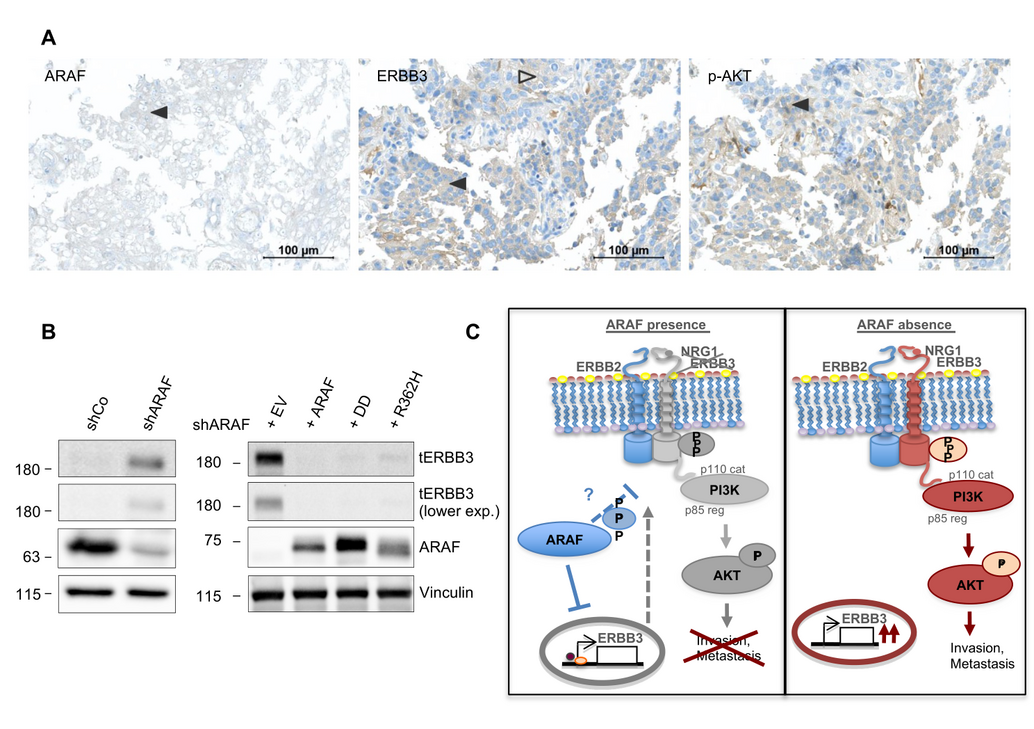
and ERBB3 in a human lung squamous cell carcinoma
sample that showed a negative staining for ARAF (H-Score < 50).
Staining was performed using tissue microarrays (TMAs).
(B) Western blot analysis of A549 showing ERBB3 protein
expression as well as ARAF knockdown (left) and reconstitution
with indicated ARAF mutants (right). (C) Illustration of the dual
role of ARAF in the regulation of ERBB3-AKT signaling axis
and metastasis.
Raf kinases promote the development of cancer cells and are therefore potent oncogenes. Despite being discovered 40 years ago, Araf remained less understood. New study from our lab unveils a tumor suppressive role for ARAF in a subset of lung cancers. Our data unveil a dual role for ARAF kinase in the negative regulation of ERBB3-AKT signalling thus regulating tumor metastasis.
Patterning of Oncogenic Ras Clustering in Live Cells Using Vertically Aligned Nanostructure Arrays
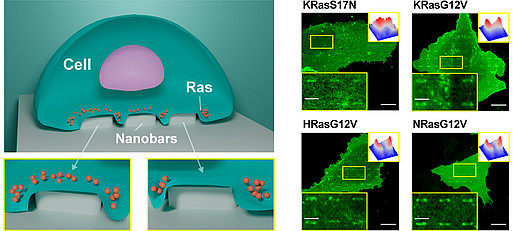
New publication on the proto-oncogene Ras. In this work, our collaborators (Prof. Zhao lab, NTU Singapore) have established an elegant nanobar-based assay to rapidly evaluate drugs by directly evaluating Ras nanoclustering in living cells and distinguishing between different Ras isoforms.
A subset of flavaglines inhibits KRAS nanoclustering and activation
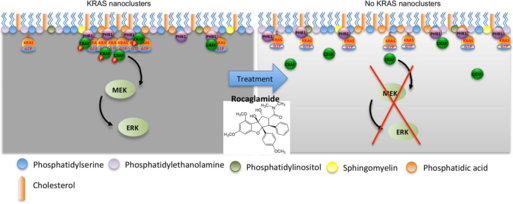
of KRAS inhibition by flavaglines.
Following up on our original observation that targeting the plasma membrane associated prohibitins led to the inhibition of oncogenic KRAS activation, we have now identified the mechanistic insights and evaluated the potency of the compounds in GEMM model. Our new publication in the Journal of Cell Science reveals that a subset of flavaglines inhibits KRAS nanoclustering and activation, making the development of flavagline derivates promising for clinical applications!
Proteogenomics analysis unveils a TFG-RET gene fusion and druggable targets in papillary thyroid carcinomas
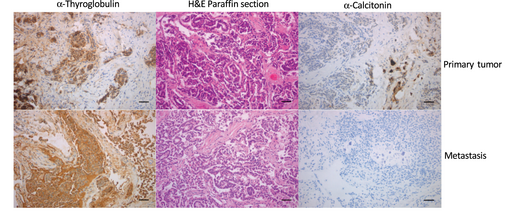
samples confirms tumor content and tissue
specificity. Shown are representative data
from the diagnostic staining procedure
suggestive of papillary thyroid carcinoma.
In our recent publication, we identified several proteins as well as a novel fusion of two genes as previously unknown causes of papillary thyroid cancer (PTC), the most prevalent type of endocrine malignancy. As now reported in the journal "Nature Communications", our discoveries could potentially lead to the development of drugs that are effective for those PTC patients who develop resistance to conventional therapeutic strategies.
ERK3/MAPK6 controls IL-8 production and chemotaxis
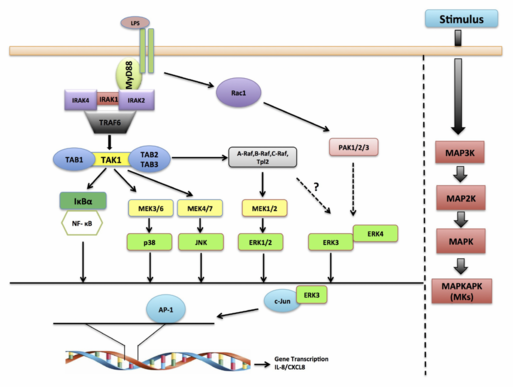
ERK3 in chemotaxis.
ERK3 controls IL-8 production and chemotaxis. Our new publication in Elife unveils a kinase-independent role of ERK3, an understudied atypical MAPK in regulating the epithelial secretome, in both normal and tumorigenic cells. We further show that ERK3 is an interacting partner of c-Jun and thus a regulator of AP-1 activity. Through its influence on the epithelial secretome, ERK3 in turn has an important impact on the chemotaxis of leukocytes to the epithelium as well as on breast cancer metastasis.
RAF kinases are stabilized and required for dendritic cell differentiation and function
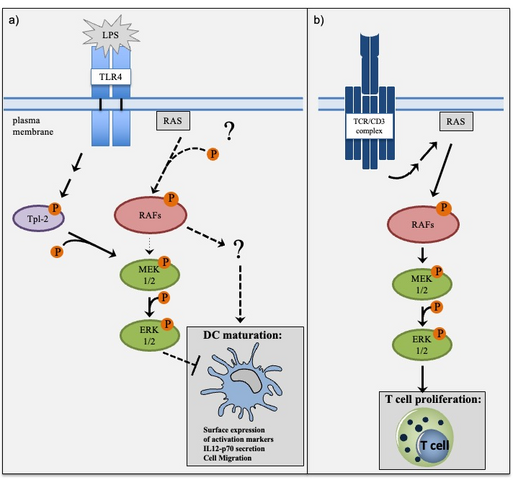
RAF-MEK1/2-ERK1/2 signaling in moDCs and
T cells.
Our recent publication in Cell Death and Differentiation describes distinct roles of RAF and MEK1/2 kinases in Dendritic Cell (DC) differentiation and activation. Though RAF and MEK1/2 are integral parts of the classical MAPK cascade, targeted inhibition of MEK1/2 kinases did not phenocopy the effect of RAF inhibitors. We found RAF kinases to be stabilized at their protein levels during DC differentiation and obligatory for normal DC function.
Targeting prohibitins with chemical ligands inhibits KRAS-mediated lung tumours
Our study suggests that „rocaglamide could function as a RAS inhibitor by uncoupling RAS-effector interaction and that targeting plasma membrane-associated PHB1 with chemical ligands may be a viable therapeutic strategy to combat KRAS-mediated Non-Small Cell lung Cancers (NSCLCs).“
Targeting prohibitins at the cell surface prevents Th17‐mediated autoimmunity
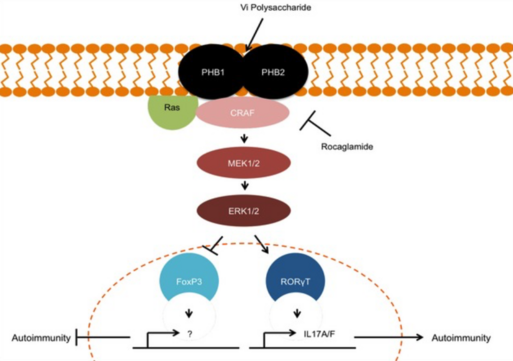
molecular signalling cascade controlling the
expression of FOXP3 and ROR?T.
Promising new therapeutic approach against multiple sclerosis (MS). In a collaboration between our lab and the lab of Univ.-Prof. Dr. Frauke Zipp, we found that in MS patients the protein prohibitin was highly concentrated on the surface of certain T cells accompanied by high CRAF activity. By disrupting the interaction between prohibitin and CRAF with polysaccharide vaccine or rocaglamide we could increase anti-inflammatory regulatory T cells, which reduced disease severity in the experimental model of multiple sclerosis.